Centbycent
In the regular decagon below, find the percentage of area that is shaded orange.
This section requires Javascript.
You are seeing this because something didn't load right. We suggest you, (a) try
refreshing the page, (b) enabling javascript if it is disabled on your browser and,
finally, (c)
loading the
non-javascript version of this page
. We're sorry about the hassle.
17 solutions
Smart. I just guessed. Your way's better.
That h length is called the apothem. :)
not the simplest solution but ok
Hey Anirudh, What software did you use to create the graphics of your solution? Thanks in advance, Elia.
The easiest way to do is: The max. % of Area 10 points can cover is 100% Therefore, the max. % of area 4 points can cover is (100/10)*4 % = 40%
The shaded area can be divided into 8 congruent triangles, as pictured below, where the blue shaded area represents 1/10 or 10% of the area of the decagon.
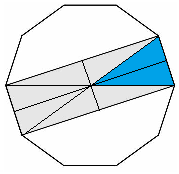
Since the blue shaded area is also 2 of the congruent triangles, each congruent triangle is 10% ÷ 2 = 5% of the area of the decagon. And since there are 8 congruent triangles shaded, the percentage of the shaded area is 8 · 5% = 40%.
nice, neat and simple. good maths
Nice smart n simple way of solving.
Definitely one of the simplest solutions
this is the easiest to understand solution. thanks
David, are you a teacher? If not, you should be!
Log in to reply
Yes, I teach high school math :-)
Log in to reply
Well, thank heavens there are people like you making stuff simple, for simple people like me. Thank you....:)
This is the least complicated explanation! Very well demonstrated; I understood perfectly with just the first sentence & the picture! Thank you!
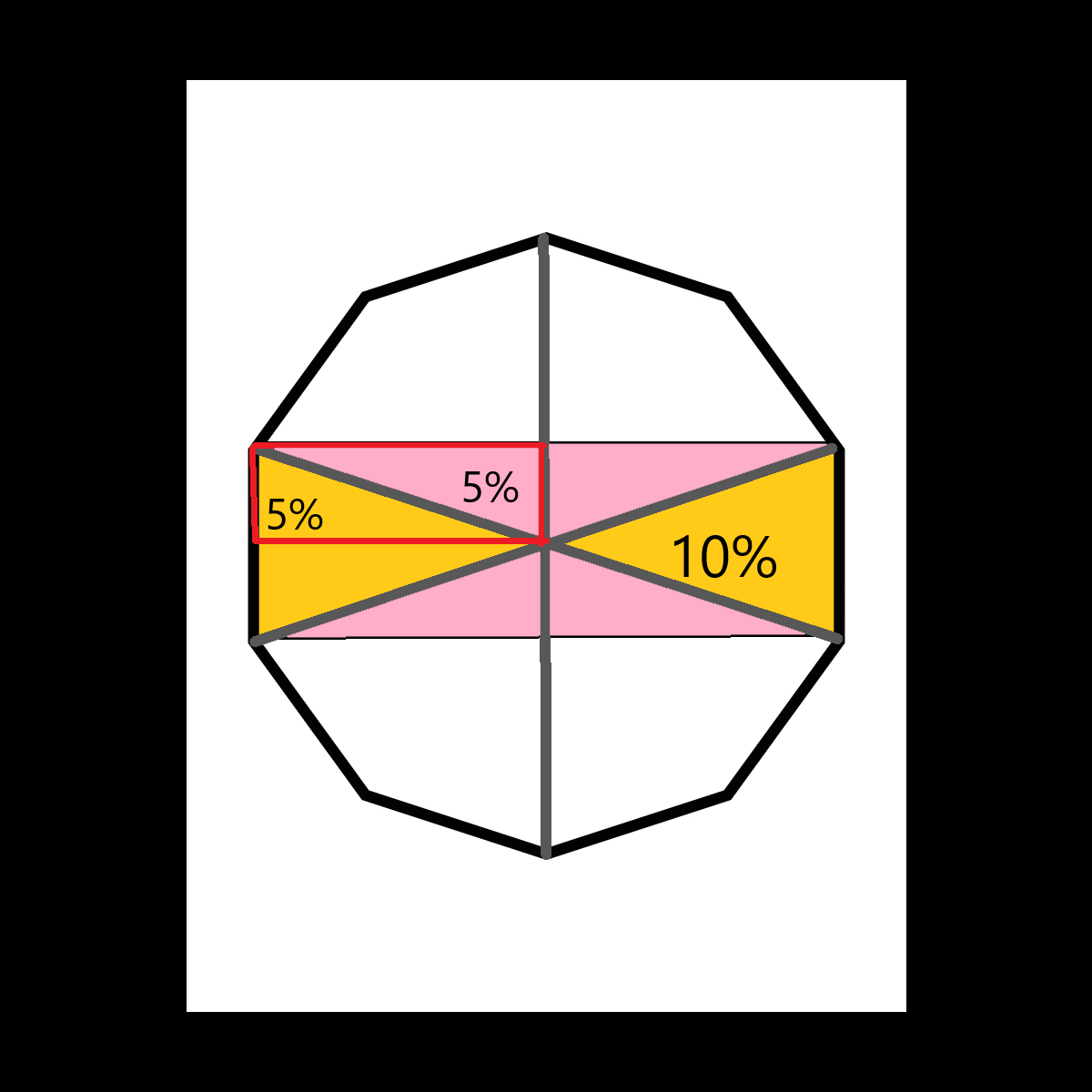 Two triangles of the decagon are equal to
20%
of its area. Of course, these triangles are equal.
Half of the one of these triangles (=5%) create a parallelogram with the boundaries given. In that way the parallelogram is equally divided in two parts by the one side of the triangle. If half of the triangle is 5% (10% : 2 = 5%) then the other equal part of the parallelogram (the triangle in pink) must be 5% too. There are 4 equal pink triangles so 5% x 4 =
20%
.
Add the sum of the two orange triangles (20% as shown above) with the sum of the pink ones (20%) you have 40%.
Two triangles of the decagon are equal to
20%
of its area. Of course, these triangles are equal.
Half of the one of these triangles (=5%) create a parallelogram with the boundaries given. In that way the parallelogram is equally divided in two parts by the one side of the triangle. If half of the triangle is 5% (10% : 2 = 5%) then the other equal part of the parallelogram (the triangle in pink) must be 5% too. There are 4 equal pink triangles so 5% x 4 =
20%
.
Add the sum of the two orange triangles (20% as shown above) with the sum of the pink ones (20%) you have 40%.
Beautifully simple explanation!
SIMPLEST Solution: If you fold the decagon on itself in a way that the shaded area is symmetric, you can see that the percentage area is divisible by 2. From there, there are only two answer choices left: 40% and 50%. We eliminate 50% by looking at the picture. Therefore, the answer is 40%. No math, just common sense!
let the side length of the decagon = a
The Shaded area A1 = 4 a 2 c o s 3 6 c o s 1 8
The total area of the decagon A2 = 4 t a n 1 8 1 0 a 2
then A 2 A 1 = 1.6 cos36sin18 = 1.6sin54sin18 = 0.40
percentage = 40 %
way too complicated!
Impressive, but that's the hard way!
Quick estimate , if we approximate decagon as circle: length of 1 side is 2π R/10 =1/5 πR Area of rectangle is about 2R × 1/5 πR = 2/5 πR×R = = 2/5 πR^2 , so it is 2/5 of the decagon, which is 40%
Area of the square : 4
h²(Pi/12)
Area of the decagon = 10xarea of triangle = 10
h²(Pi/12)
So the Area of the square = 4/10 = 40% of the total area.
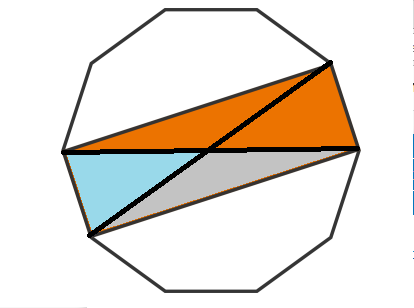 Area of blue triangle is same as area of grey triangle as separated by median. grey triangle is 10% of total area and hence the rectangle is 40% area
Area of blue triangle is same as area of grey triangle as separated by median. grey triangle is 10% of total area and hence the rectangle is 40% area
Nice! Key element of this solution is the observation that the larger triangles are "separated by median". Simplest solution yet!
All results given so far are of course correct, but I want to add simpler solution: The area of the rectangle ABFE is (2xCD)xAB. The area of the triangle ABC is (ABxCD)/2 and it is 1/10 of the area of the decagon. So the ratio of the area of the rectangle to that of the degagon is (2xCDxAB) / (10xABxCD)/2) = 2/5 = 40%
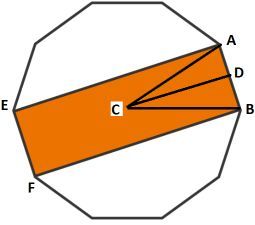
so with my extraordinary paint skills i drew this wich reflects my rather simple first thought quite acurately
Let’s say a is the apothem and p is the perimeter of the regular decagon, and the side length of the decagon is 1 0 p (the number of sides).
The area of the whole decagon can be found by the formula: A = 2 a × p
The area of the rectangle is: A = b × h = 2 a × 1 0 p = 5 a × p
Therefore, the ratio of the area of the rectangle to the area of the decagon is: 2 a × p 5 a × p = 5 2 = 40%
Quick estimate , if we approximate decagon as circle with area πR^2, then: length of 1 side is ~2π R/10 = 1/5 πR Area of rectangle is about 2R × 1/5 πR = 2/5 πR×R = = 2/5 πR^2 , so it is 2/5 of the decagon, which is 40%
Approximate method
Area of inscribing circle = pi() r.r
Approx Width or rectangle = 2 pi() r / 10
Approx Length of rectangle = 2 r
Approx Area of rectangle = 0.4 pi() r.r
= 40% of circle area
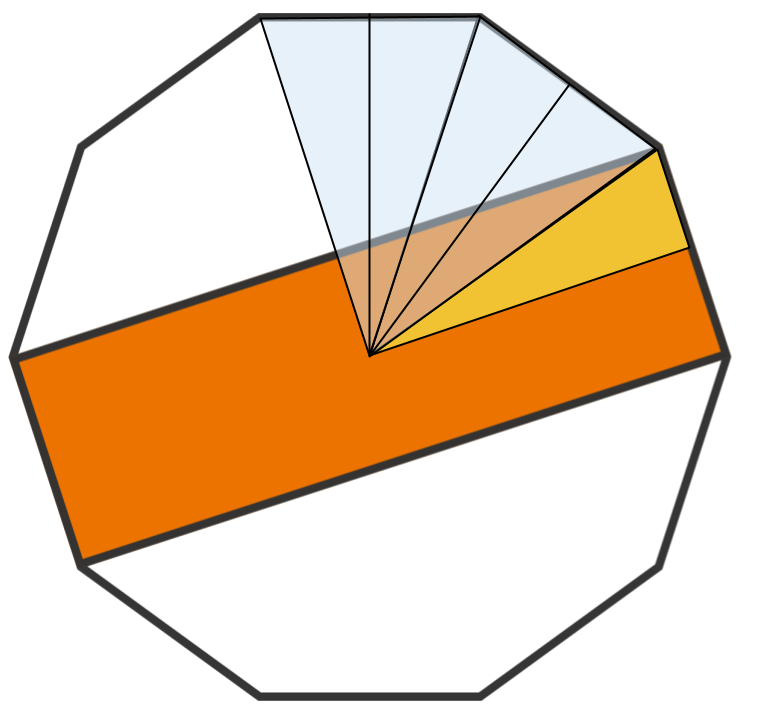
4 1 of the decagon consists of 5 congruent triangles.
4 1 of the shaded region consists of 2 of those triangles.
5 2 = 40%.
I saw it graphically first, but had to verify it with algebra. It’s very simple, though. Divide the area of the rectangle by area of decagon. (Sides are s, apothem is a)
Area rectangle: 2 X a X s
Area decagon: (.5 X a X s) X 10 = 5 X a X s (area of one triangle times 10)
(2 X a X s)/(5 X a X s)= (2/5)((aXs)/(aXs))=(2/3)= 40%
(David Vreken’s post has a picture showing the length of the rectangle is 2 X a.)
I figured the shaded of the decagon contained at least 10% of the decagon on both sides. This considered, I just needed to approximate the area on either side of that 10%. I thought that the area in the triangles either side of the 10% on both sides were exponentially decreasing infinitely which, in theory, suggests the area would eventually add to 20% on both sides. Therefore, I figured the area occupied by the orange shading equated to 40% that way. Criticism of my solution is very welcome.
I used the formula for the area of a regular decagon A = 2.5ad, where side length is a and d is the distance between parallel sides. Since ad is expressing the area in orange and 2.5x that is the whole area, 1/2.5 = 0.4, or 40% of the total area.
Feels like deriving that formula is the meat of the problem here. Why is the area of a regular decagon equal to A = 2.5ad? Does this generalize to regular n-gons?
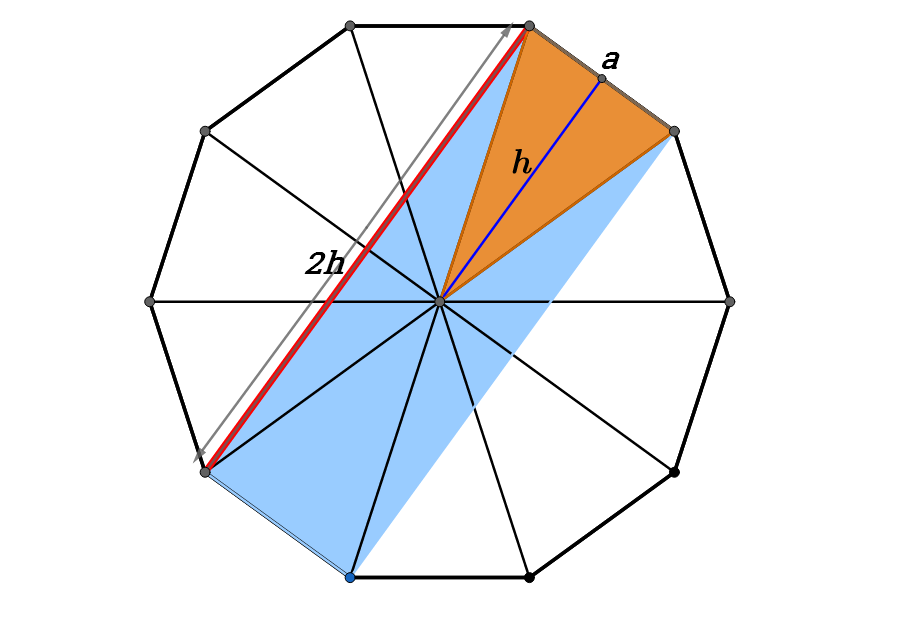
In general, from the diagram I borrowed above:
A n − g o n = 2 n a h and A o r a n g e s t r i p = 2 a h ⟹ 2 a h = 1 0 0 x 2 n a h ⟹ x = n 4 0 0
Using n = 1 0 ⟹ x = 4 0 % .
Or using the actual areas:
Let r be the radius of the circumscribed circle.
a = 2 r sin ( n π ) and h = r cos ( n π ) ⟹ A n − g o n = 2 n sin ( n 2 π ) r 2 and A o r a n g e s t r i p = 2 sin ( n 2 π ) r 2 ⟹
2 sin ( n 2 π ) r 2 = 1 0 0 x 2 n sin ( n 2 π ) r 2 ⟹ x = n 4 0 0
Using n = 1 0 ⟹ x = 4 0 %
Area of regular polygon = na²(cot π/n) ÷2 For decagon n=10, Area= 5a²cot 18° Area of rectangle = a × b.( b>a) % of area = b/ (a cot18°) × 20= 2× 20℅ =40%
Area of uncovered surface is symmetrical = 2×( area of 2 squares and area of 4 right angled triangle)
The area of the decagon is 5 s r where s is the side length and r is the apothem. If we now take a look at the rectangle, one of its sides has length s and the other has length 2 r so the area of the rectangle is 2 s r . We can now compute A d e c a g o n A r e c t a n g l e = 5 s r 2 s r = 5 2 .
In the above figure we have,
The area of the orange triangle Required area = 1 0 1 × The area of the decagon = 2 1 × a × h = a × 2 h = 4 × ( 2 1 × a × h ) = 4 × ( area of the orange triangle ) = 1 0 4 × area of the decagon = 4 0 % of the area of the decagon